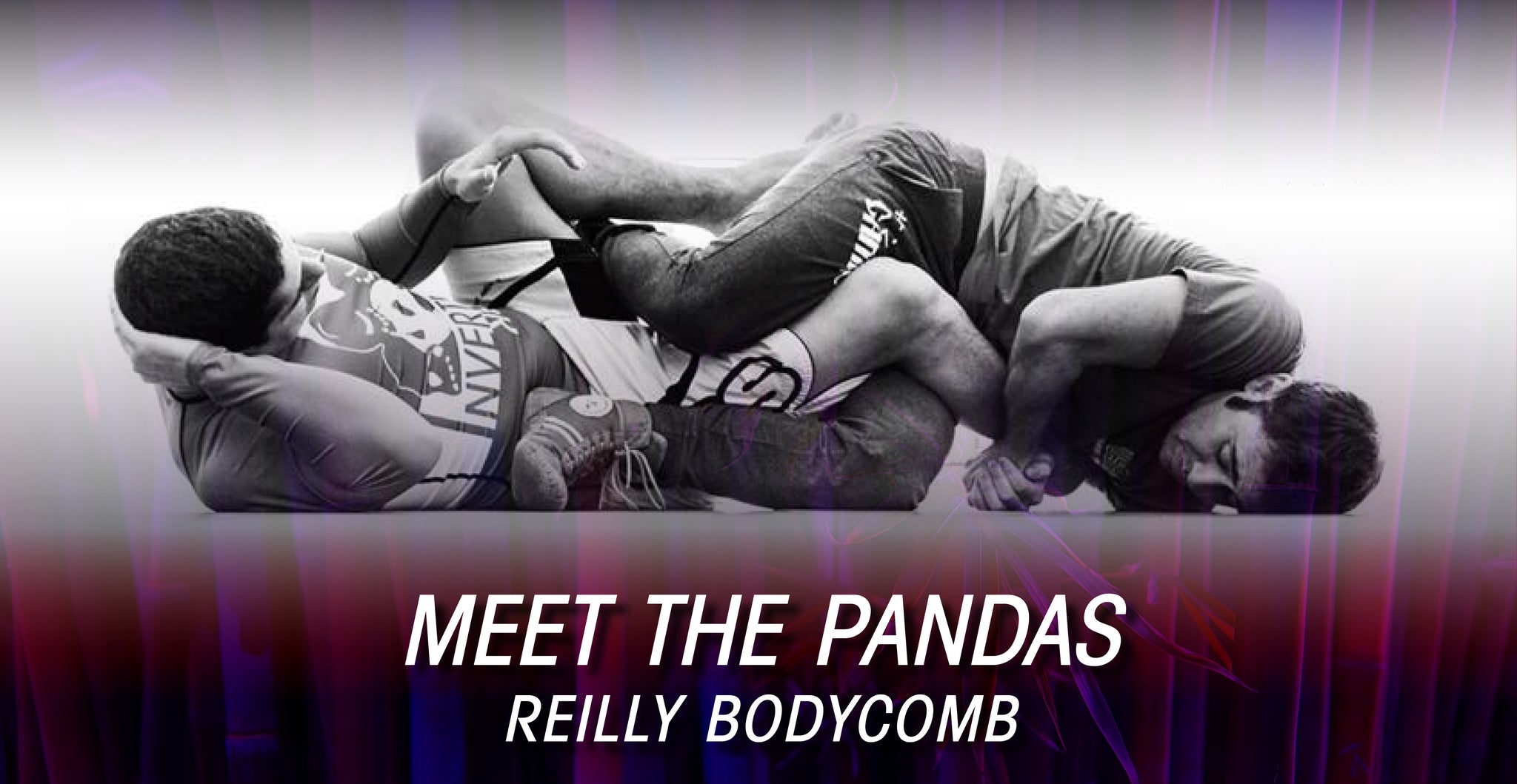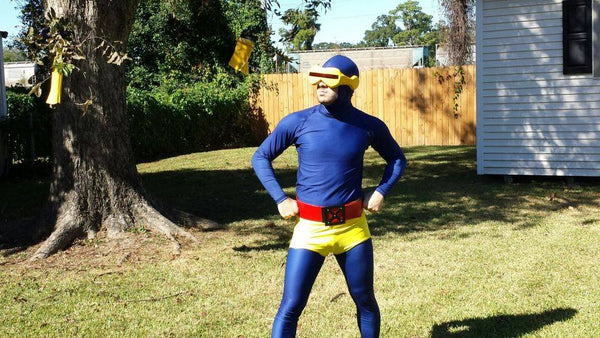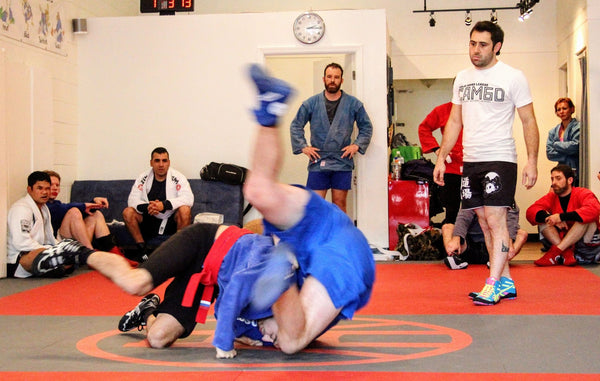Meet the Pandas – Reilly Bodycomb – The Flying Scissor Leglock Wizard

We like to give some insight in what drives our sponsored athletes, and why we are proud to support them. Previously, we talked to Eric Sian, Guam’s first world champion grappler. For this installment of Meet the Pandas we speak to Reilly Bodycomb: sambo champion, leglock wizard and all-round badass grappler.
Reilly Bodycomb (32) has been leglocking people into submission since 2005. He became famous for his own dynamic, take-no-prisoners grappling style – honed by his instructor ‘Sambo’ Steve Koepfer at New York Combat Sambo, his excellent coaching ability, and his willingness to share his leglock knowledge in various instructionals. Reilly’s been on a tear this year, winning gold at the Sambo Nationals, the Sambo Pan-Ams and the Dutch Sambo Open – among others.
How did you fall in love with sambo?
Reilly Bodycomb: When I stepped on the sambo mat at New York Combat Sambo, around 2005, it wasn’t the first time I’d experienced grappling. At the time I was a karate instructor in Brooklyn, and I had done some jiu-jitsu and judo before. So I would roll pretty consistently in our school and at various other gyms. However, it was my first time encountering a particular class structure that wasn’t traditional. A sambo gym is run closer to a wrestling or boxing club. There’s no bowing, no rank and no formality. That was both interesting and foreign to me. It turned out to be something I’d been looking for all my life, but just didn’t know it. I really liked the openness, focusing on what works best for your body type. Now, in retrospect, I realize that is not a universal characteristic of the sport. There are some gyms that have a more narrow perspective, as I found out during my travels. But New York Combat Sambo really had this open-minded attitude. One of my favorite things about training there, was that we went really wide with the rulesets. I was able to compete in sanshou kickboxing, MMA, combat sambo, sport sambo, freestyle sambo and submission grappling.
So it wasn’t your first time grappling, but did you get your ass kicked?
RB: I can’t remember (laughs). I had my first taste of getting absolutely crushed and dominated by a grappler several years before, when I went to train at an MMA gym. Like every other striker trying grappling for the first time, I got stuck underneath someone and couldn’t get out. That’s when I had that big revelation we all experience at the start of our journey: “Wow, this stuff really works! I have to learn more!”

Aside from the mindset, what else attracted you to sambo?
RB: My coach Stephen Koepfer taught striking and grappling combined in almost every class. You had gloves, shinpads and sometimes a jacket on. Grappling was mostly taught and discussed within the context of a real fight, so with strikes. There was a universal approach to sambo that I really appreciated. The fundamentals of the art – as they were taught by Steve – were a combination of striking and grappling. Everything was synched. So that gave me a great base to explore other arts. You often see the reverse in a lot of modern jiu-jitsu gyms, where striking is not addressed at all, or only reserved for higher level students.
Sambo seems to place a lot of emphasis on developing general movement first, specific technique second. What are your thoughts on that?
RB: Steve learned that from his coach Alex Barakov, and it’s a very effective approach. We focus on a lot of flowing movements, rolling and tumbling. But they serve a specific purpose. When I teach class and I warm up the room, I’m showing how to do rolls in a way that can be used combatively. For example: when you practice forward rolls across the mat and you’re posting out your hand, you’re not rolling in a way that you’d ever use in fighting. Because when you’re rolling in a fight, your hands are probably busy grabbing the jacket or hooking a leg. Same thing if your forward roll is taking you far across the mat. Sure, that’s nice for a warm up, but that situation won’t really happen in a fight. You’re more likely to kind of roll back or invert in the same spot, like when you’re attacking a kneebar from standing. Another example, our backward rolls are primarily used to train our entries for sacrifice throws, it’s not just rote repetition. We place a great emphasis on weaponizing our rolls.
So that’s where your spectacular sliding, jumping and rolling attacks come from?
RB: Exactly. Those dynamic entries don’t feel dangerous to me. When I’m teaching I realize just how important that stuff is. At a glance rolling leglocks seem crazy and unorthodox, but once you have fundamental body control and awareness, those dynamic entries are totally reasonable. During my career I’ve hit those moves consistently, now my students are hitting them too. That’s no coincidence. If you teach those fundamentals correctly they are transmittable. You just have to train them a lot in order to be able to pull the trigger when you see the opportunity. Those moves not only effective in a real fight – they also look awesome. It’s not just dancing. Luckily I found the right coach to help me develop that aspect of the game. The very first point I ever scored in a sambo match was a flying scissor takedown. It became clear that I had an aptitude for this. Being more dynamic was what actually felt easy to me.

You’ve been on a tear this year, winning a lot of competitions. What’s gotten into you?
RB: My ideal vision is working towards a fast-paced, dynamic, stand-up oriented grappling style. I want to be technical and well-rounded, and that means taking a lot of information from different sources – like jiu-jitsu, wrestling or judo – and then pouring that through a sambo filter. For me, the most important thing is to be a dynamic martial artist. It’s way more important than being just a ‘sambo guy’. Sambo just happened to be the best vehicle for the way my brain works, and how I can express what I think is cool in martial arts. I want to win on the feet, get the takedown and not get thrown myself, and/or winning dynamic entries to mat work. On the mat I want to submit my opponent as fast as possible. If I can’t, then I’m getting back to my feet quickly. That’s my lens. I figured the best thing would be to return to the sport that enforces that particular mindset and behavior. So this year I decided to push hard into my root sport. I went full circle. It’s kind of cathartic.”
Is there one win or tournament medal that’s especially important?
RB: Actually, there are three. When I fought in MMA in 2007 I won by double leg, mount and ground & pound. After that I stumbled into the sport of submission grappling, and I noticed there was a massive skill gap when it came to heelhooks. So I was able to win a bunch of grappling tournaments with heelhooks because people weren’t familiar with them. It’s not that I was super good or anything, at that time there was just a skill gap – which is obviously closing now. For a couple of years I went deep down the rabbit hole of leglocks, and I developed all sorts of dynamic entries into the heelhook. Around 2013, while my wife was pregnant with our daughter, I really wanted to win another MMA fight, but this time using a leglock. It was important to me to check if I hadn’t wasted my time, developing a skillset that would only work in submission grappling. I went to work with the help of my friend and BJJ black belt Colin Murray, and sure enough I was able to win a MMA fight by heelhook, before my daughter was born. That was a true pressure test of what I’d been working for all those years.
Furthermore, this year I won the sambo Pan-Ams. To enter that tournament you have to win your county’s nationals – which I did, and that was the first tournament that gave me an international sambo ranking. Americans don’t show up on that board easily. Seeing that gold medal elevate me to fifth in the world at 68 kg was truly amazing.

And winning combat sambo in Holland for the first time, again this year, was huge. Last time I fought under that ruleset was in 2006, I lost and didn’t do it again for years. I did fight MMA in between, but still it was super scary to put myself out there again. I was in a foreign country with just my Belgian friend Wannes De Roover. For some reason it was a really violent tournament. A dude got knocked out cold right in front of me, and had to be carried off the mat. I thought: “Man, WHY am I doing this?!” I imagined waking up in a Dutch hospital somewhere. Thankfully, in the first match I manage to suplex the guy and pin him for four points, so that’s an eight point technical win. In the second match I pulled off a sitting armbar-triangle combination. I won that tournament and came out pretty unscathed, while people around me were dropping like flies.
What keeps you fascinated about the art?
RB: I like trying to find areas of the game that don’t come natural to me, and that I can develop into strengths. Like throws and takedowns. In 2010 I fought in NAGA and I got taken down by a really good wrestler. People said: “Of course, he’s a former D1 wrestler”. But I thought to myself: “I never want to get taken down again!” When I discovered there was such a big hole in my game I got super angry, and I started to work on my takedowns and throws. Nowadays when I face a good wrestler I feel I HAVE to take him down, not just roll underneath him for the heelhook. There’s so much territory in grappling that still I have to explore.
At 32, is your body is still functioning?
RB: No (laughs). My back is very bad and I had surgery on my elbow, and it all just keeps getting worse. I definitely walk around like an old man most of the time. This year was the first time I actually went to see a chiropractor and I started to so do some mobility work. Yeah, I might also look into yoga.

Leg attacks in submission grappling have become really popular. It must be cool to see that they’re here to stay.
RB: Yeah, it’s very interesting to see the progress, and I think I had a part to play in that. At the same time it makes me want to focus on something else. Now I just love throwing people. This year I hit my first total victory throw in combat sambo. That’s when you throw the opponent squarely on their back while remaining standing, it’s the sambo version of scoring ippon. I’d never done that before. You see, my interests shift a lot. I guess that’s the grappling-hipster in me.
If you had to pick: fighting or coaching?
RB: I’ve always been more of a coach than a fighter. I always dreaded competition because, honestly, it’s not really fun. Competing in martial arts was less about me trying to win, and more about making sure that the material I was coaching was legit. That’s why winning combat sambo or in MMA was so important to me. It’s obviously not the same as fighting in the UFC, but it sets me up to have a little bit more confidence when I’m helping someone compete at a higher level. All athletes hit a wall at a certain point. But if you’re successful at transmitting information as a coach, you can keep going.
In conclusion, tell us about the RDojo Sambo League you’re setting up with Inverted Gear.
RB: Sambo offered me a different viewpoint to look at grappling. However, the art is not really accessible to people (in the United States, at least). I wanted to create a way for people to actually experience sambo. Not just by learning individual techniques in a seminar setting, but to actually get on the mat and try out the rules. The RDojo Sambo League is a nationwide series of in-house tournaments that use slightly modified sambo rules, which are more accessible to jiu-jitsu practitioners, while still keeping the essence of the art intact. The league has a round-robin format so people get several matches. We thought it would be a cool way for people to experience the game in a friendly environment. That way they get to hone new skills, which they can apply to their own combat sports. And no, there will be no belt divisions. You just go for it.

Follow Reilly Bodycomb on Instagram @Rdojo.
For more info on the RDojo Sambo League visit www.Rdojo.com/league
About the Author Daniël Bertina
Daniël Bertina is a journalist and writer based in the Netherlands. He holds a black belt in BJJ under Marcos Flexa of Carlson Gracie Amsterdam. Follow him on Twitter and Instagram at @joyofirony.
Other articles:
Quick links
Contact us
About us
Quality BJJ gear at fair prices, available all year. Founded in 2012 to provide an alternative to high-cost, limited edition gis. Dive into the BJJ lifestyle with us—join the Panda Nation!"
